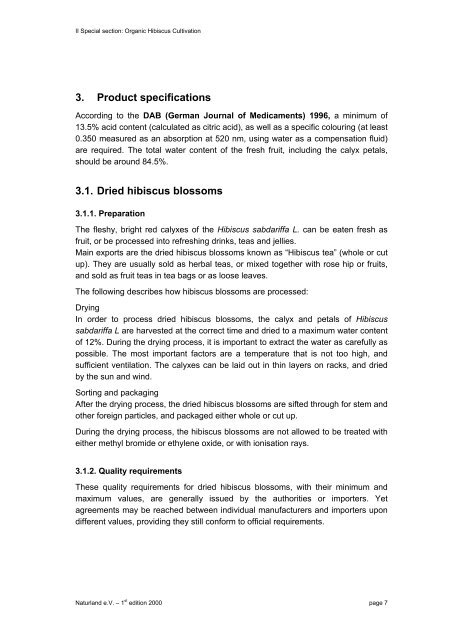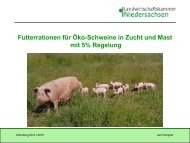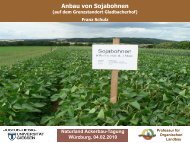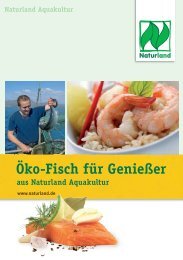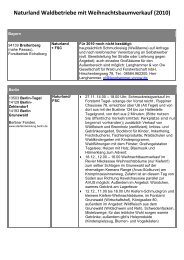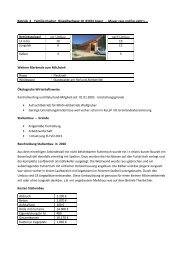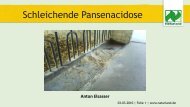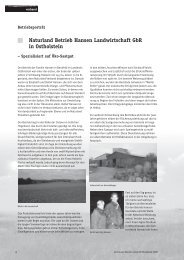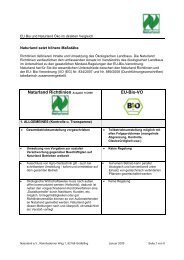Organic Farming in the Tropics and Subtropics: Hibiscus - Naturland
Organic Farming in the Tropics and Subtropics: Hibiscus - Naturland
Organic Farming in the Tropics and Subtropics: Hibiscus - Naturland
Create successful ePaper yourself
Turn your PDF publications into a flip-book with our unique Google optimized e-Paper software.
II Special section: <strong>Organic</strong> <strong>Hibiscus</strong> Cultivation<br />
3. Product specifications<br />
Accord<strong>in</strong>g to <strong>the</strong> DAB (German Journal of Medicaments) 1996, a m<strong>in</strong>imum of<br />
13.5% acid content (calculated as citric acid), as well as a specific colour<strong>in</strong>g (at least<br />
0.350 measured as an absorption at 520 nm, us<strong>in</strong>g water as a compensation fluid)<br />
are required. The total water content of <strong>the</strong> fresh fruit, <strong>in</strong>clud<strong>in</strong>g <strong>the</strong> calyx petals,<br />
should be around 84.5%.<br />
3.1. Dried hibiscus blossoms<br />
3.1.1. Preparation<br />
The fleshy, bright red calyxes of <strong>the</strong> <strong>Hibiscus</strong> sabdariffa L. can be eaten fresh as<br />
fruit, or be processed <strong>in</strong>to refresh<strong>in</strong>g dr<strong>in</strong>ks, teas <strong>and</strong> jellies.<br />
Ma<strong>in</strong> exports are <strong>the</strong> dried hibiscus blossoms known as “<strong>Hibiscus</strong> tea” (whole or cut<br />
up). They are usually sold as herbal teas, or mixed toge<strong>the</strong>r with rose hip or fruits,<br />
<strong>and</strong> sold as fruit teas <strong>in</strong> tea bags or as loose leaves.<br />
The follow<strong>in</strong>g describes how hibiscus blossoms are processed:<br />
Dry<strong>in</strong>g<br />
In order to process dried hibiscus blossoms, <strong>the</strong> calyx <strong>and</strong> petals of <strong>Hibiscus</strong><br />
sabdariffa L are harvested at <strong>the</strong> correct time <strong>and</strong> dried to a maximum water content<br />
of 12%. Dur<strong>in</strong>g <strong>the</strong> dry<strong>in</strong>g process, it is important to extract <strong>the</strong> water as carefully as<br />
possible. The most important factors are a temperature that is not too high, <strong>and</strong><br />
sufficient ventilation. The calyxes can be laid out <strong>in</strong> th<strong>in</strong> layers on racks, <strong>and</strong> dried<br />
by <strong>the</strong> sun <strong>and</strong> w<strong>in</strong>d.<br />
Sort<strong>in</strong>g <strong>and</strong> packag<strong>in</strong>g<br />
After <strong>the</strong> dry<strong>in</strong>g process, <strong>the</strong> dried hibiscus blossoms are sifted through for stem <strong>and</strong><br />
o<strong>the</strong>r foreign particles, <strong>and</strong> packaged ei<strong>the</strong>r whole or cut up.<br />
Dur<strong>in</strong>g <strong>the</strong> dry<strong>in</strong>g process, <strong>the</strong> hibiscus blossoms are not allowed to be treated with<br />
ei<strong>the</strong>r methyl bromide or ethylene oxide, or with ionisation rays.<br />
3.1.2. Quality requirements<br />
These quality requirements for dried hibiscus blossoms, with <strong>the</strong>ir m<strong>in</strong>imum <strong>and</strong><br />
maximum values, are generally issued by <strong>the</strong> authorities or importers. Yet<br />
agreements may be reached between <strong>in</strong>dividual manufacturers <strong>and</strong> importers upon<br />
different values, provid<strong>in</strong>g <strong>the</strong>y still conform to official requirements.<br />
Naturl<strong>and</strong> e.V. – 1 st edition 2000 page 7


